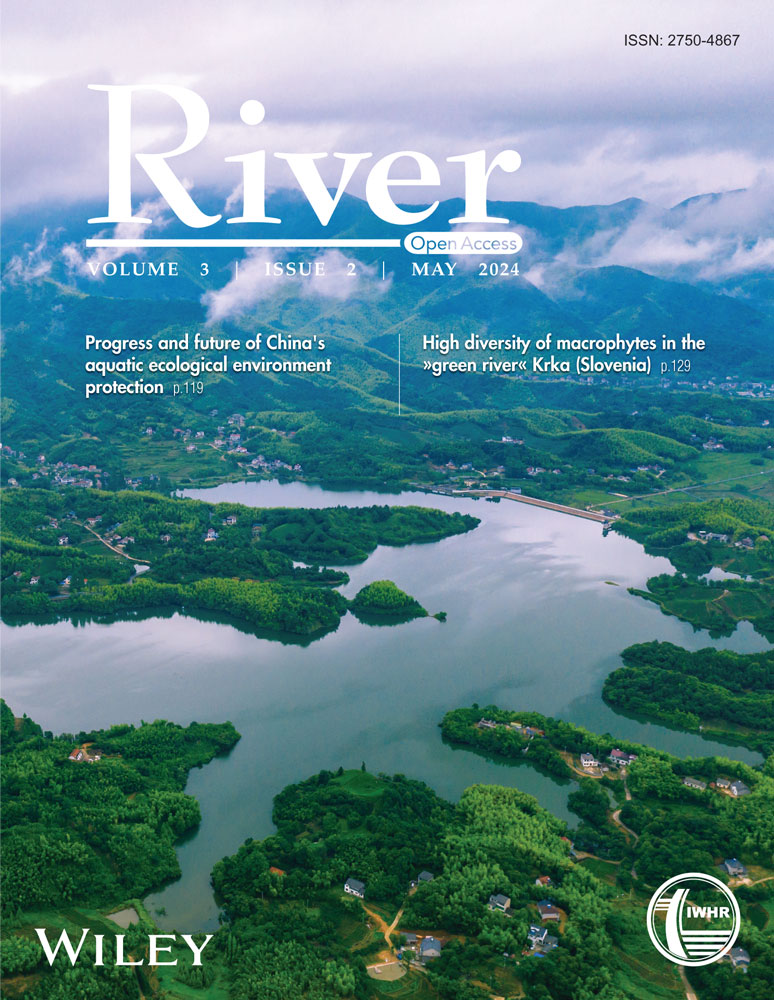High diversity of macrophytes in the »green river« Krka (Slovenia)
Abstract
The presence, abundance, and distribution of aquatic macrophytes and their growth forms in the river Krka in Slovenia were studied. The studied slow-flowing lowland River Krka is also called a »green river« since it is overgrown with macrophytes from its source to its outflow to the river Sava. The environmental parameters of the river ecosystem were also assessed using the modified version of the RCE (Riparian, Channel, and Environmental Inventory) method. Within 24 sections reaching from 100 to 250 m, 23 taxa of macrophytes were found. Sections were distributed noncontinuously from the source to the outflow more or less equally along the river course. The invasive alien species Elodea canadensis reached the highest relative abundance, followed by Ranunculus trichophyllus, Potamogeton crispus, Myriophyllum spicatum, Ceratophyllum demersum, and Potamogeton nodosus. Potamogeton crispus was present in most of the studied sections followed by Nasturtium officinale and M. spicatum. The river offers suitable conditions for the high diversity of macrophytes regarding the type of substrate, low flow velocity, heterogeneity of habitats, and relatively high concentrations of nutrients. In comparison to the survey performed in 2003, when the river Krka was surveyed continuously from the source to the outflow, we found that seven of the submerged and natant macrophytes were not detected in 2020. Macrophytes, growing in the river Krka, indicated meso- to eutrophic conditions. Five species recorded in the river Krka are listed on the Red list of endangered species in Slovenia, indicating the need to conserve the river ecosystem.
1 INTRODUCTION
Rivers created important places where numerous people settled in ancient times and the first great civilizations began by rivers such as Huang He (Yellow River), Indus, Nile, Tigris, and Euphrates (Macklin & Lewin, 2015). These civilizations used rivers to supply them with water, food, and building materials (Zelnik & Germ, 2023). Rivers and their watersheds comprise some of the largest inland macrosystems on earth (Thorp et al., 2023), offering a habitat for many organisms and influencing the area's microclimate conditions. Natant and submerged macrophytes, as well as helophytes, are an important part of the aquatic systems and landscape (Guo et al., 2023). Macrophytes with different growth forms show various functional traits and also ecological functions (Shan et al., 2024). The main environmental parameters affecting the growth of macrophytes in lowland rivers are flow velocity and discharge, light conditions, type of substrate, competition, nutrient status, and river management practices (Franklin et al., 2008).
Macrophytes are important components in river ecosystems, affecting their physical, chemical, and biological characteristics. In dense macrophyte stands, the flow is slower, and the sediments are deposited. Macrophytes physically hinder water movement, contributing to flow resistance (Bulat et al., 2019). Macrophytes also enhance water quality by accumulating nutrients from the water and maintaining ecosystem balance (Ahmad Lone et al., 2014). Thus, macrophytes have an important role in the conservation ecology and affect the diversity and composition of other biotic communities (O'Hare et al., 2018). For example, Potamogeton crispus enhanced the diversity of epiphytic algae by lowering nutrient concentrations and enhancing water transparency (Lv et al., 2019). Macrophytes affect animal communities, enhance biodiversity and heterogeneity of habitat, and provide shelter and feeding sites (Thomaz & Cunha, 2010) for invertebrates and other organisms such as fish (Cortelezzi et al., 2013). Henninger et al. (2009), for example, evidenced that the association of isopod Exosphaeroma hylocoetes with Ruppia maritima offers the benefit because vegetation provides refuge against fish predation and sites of increased food availability. Macrophyte stands are hiding places for zooplankters when they want to escape from predators. On the other hand, macrophytes also provide a niche for various macroinvertebrate assemblages. The favorable and unfavorable effects of macrophyte refugia for zooplankton depend on predacious macroinvertebrates that can lower the zooplankton population (Sagrario et al., 2009).
The Krka River is the longest right tributary of the river Sava in Slovenia. It originates in the karst area of Suha Krajina, flows through the city of Novo mesto and along the entire length of the Krško basin, and flows into the River Sava near Brežice, close to the border with Croatia. It is the second-longest river with an entire flow within Slovenia.
We aimed to find out the diversity, abundance, growth forms, and distribution of macrophytes in the river Krka. We also aimed to find out how the species' richness changed over 17 years.
2 MATERIALS AND METHODS
2.1 Study area
The Krka River catchment area, with its many tributaries and karst springs, covers an area of 2284 km2, which represents as much as 10% of the Slovenian territory. The length of the river is about 90 km. The river has a gentle slope, which enables the formation of many travertine cascades and blocks, which, together with dams, greatly influence the river flow (Germ et al., 2008). We choose 24 river sections from the source to the outflow. The river map with the studied sections is presented in Figure 1.
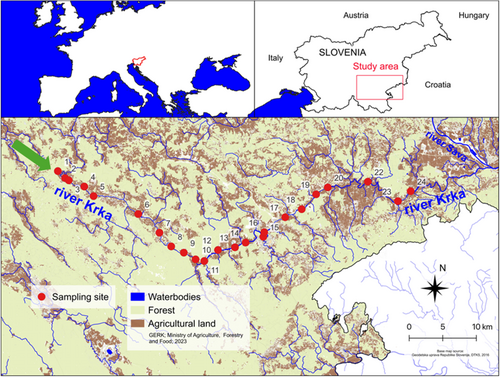
2.2 Macrophyte survey
The presence and abundance of the macrophytes were assessed from the boat in 24 sections, whose length was from 100 to 250 m. An abundance of macrophytes in every section was evaluated on 5 degree Kohler scale (Kohler & Janauer, 1995). Values were transformed by the function x3, as reported by Schneider and Melzer (2003). The relative plant abundance RPA and mean mass index (MMI) were calculated using the method (Pall & Janauer, 1995). The black bars in Figure 5 are proportional to MMItot (the mean mass index based on the total number of sections for each species). The outlined bars are a measure for the MMIocc (the mean mass index used when calculated for the sections where the species occurs). Detrended correspondence analysis (DCA) was conducted to provide us with information about the gradients in the matrix of macrophyte species and to find out the relations between the structure of macrophyte communities and gradients obtained using the data about the abundance of functional groups of macrophytes (submerged, natant, amphibian, and emergent), which were passively projected to the ordination diagram.
2.3 Physical and chemical parameters of the water and assessment of environmental parameters
The boundaries between the sections were determined according to changes in the presence and richness of macrophytes or certain environmental parameters such as flow velocity, land use type, riparian vegetation, or substrate. Their positions were recorded using a GPS device. In each section, the distribution of macrophytes, RCE (Riparian, Channel, and Environmental Inventory) assessment of the environmental parameters of the watercourse, and the physical and chemical parameters were measured. The physical and chemical parameters were measured using a multimeter (Eutech Instruments PCD 650). Nitrates were determined using the sodium salicylate method. Extinction values at 430 nm were measured using a spectrophotometer HACH Lange LT 200.
The RCE method can be used to assess the watercourse's ecomorphological characteristics, such as the riverbed physical characteristics, riparian vegetation, and catchment area characteristics. The modified RCE method evaluates 12 different environmental parameters and is used to assess the status of lowland watercourses. According to the total sum of the values for environmental parameters, we classify the river into one of five quality RCE classes (Petersen, 1992).
3 RESULTS AND DISCUSSION
3.1 Macrophytes
Species were unevenly distributed along the river course (Figure 2). Taxa such as Berula erecta, Chara spp., Elodea canadensis, Myosotis scorpioides, Nasturtium officinale, Ranunculus trichophyllus, Sparganium erectum agg., and Veronica anagallis-aquatica were present in the upper part of river, while Ceratophyllum demersum, Najas marina, Potamogeton pectinatus, Potamogeton nodosus, and Sparganium emersum were present in the lower part of the river. Species thriving in the lower part of the river are more common in eutrophic waters (Kuhar et al., 2011). Lemna minor, Myriophyllum spicatum, P. crispus, and P. natans were distributed more or less equally along the examined sections, indicating their wide ecological amplitude (Preston, 1995).

E. canadensis, M. spicatum, N. officinale, and P. crispus were found within at least half of the examined sections, while Alisma plantago-aquatica, Callitriche sp., Leersia oryzoides, Najas marina, Schoenoplectus lacustris, and Phalaris arundinacea were distributed only in one or two sections (Figure 3).
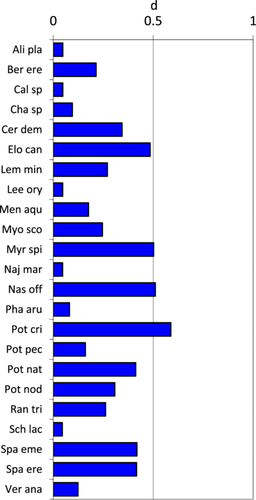
Invasive alien species E. canadensis reached the highest RPA value in the river Krka (Figure 4), which is concerning in terms of biodiversity conservation. The first record for this species in Slovenia goes back to the early thirties of the 20th century (Kuhar et al., 2010). Within the study of Slovenian watercourses, it was evidenced that E. canadensis preferred waters flowing through the agricultural landscape, with a narrow riparian zone, with moderate presence of the retention structures, and with sediment consisting of gravel, sand, and silt (Kuhar et al., 2010). Species did not grow in the parts of watercourses with the fast flow. These are the conditions that are common for the habitats in the river Krka. Kuhar et al. (2010) discovered that E. canadensis did not express its invasive character in Slovenian heterogeneous territory. Similarly, it was recently reported (Zelnik et al., 2022) that there was no negative effect of the invasive alien Elodea species on the species richness and diversity of native flora in waterbodies in the floodplain of the Drava River in Slovenia. Even though E. canadensis reached the highest RPA, it was not the only species in any of the surveyed sections in the river Krka. Moreover, it was not found in the lower part of the river Krka, where it grew in 2003 (Germ et al., 2008).
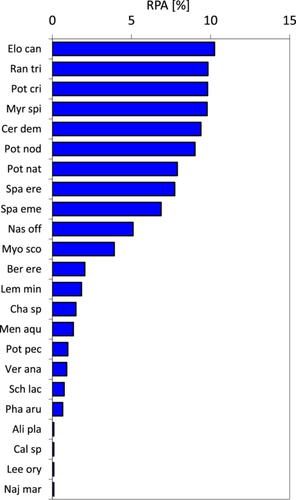
High RPA was reached also by R. trichophyllus, followed by P. crispus, M. spicatum, C. demersum, and P. nodosus. R. trichophyllus was present in a small number of sections, but with great abundance, especially in the upper part of the river. P. crispus was distributed more or less equally on the whole length of the river but not with a high abundance. P. crispus was also recorded along the entire Ljubljanica River (Slovenia), a slowly flowing river with a gentle slope, similar to river Krka (Germ et al., 2021). Species of the genus Potamogeton grow in habitats with slow or moderate flow and fine substrate in mesotrophic or eutrophic water (Preston, 1995). The mentioned conditions are typical for the river Krka, where four species from the genus Potamogeton were found (Figure 2). P. crispus and P. pectinatus are indicators of eutrophic waters together with M. spicatum and Sparganium erectum agg. (Haslam, 1987; Preston, 1995; Schneider & Melzer, 2003). All these species were found in the river Krka in both survey years.
C. demersum, P. nodosus, and R. trichophyllus were not present in many river sections but were highly abundant in certain river sections. This was seen in Figure 5, where long outlined bars further extend beyond the black bars, indicating the disconnected, clumped distribution of these species.
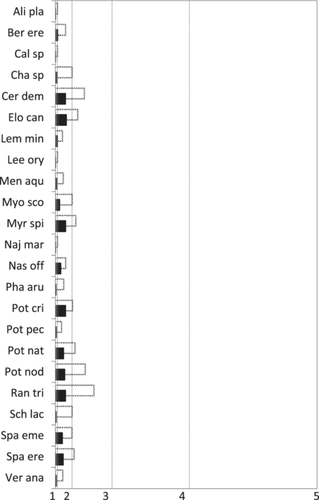
The number of submerged species increased downstream (Figure 6), which can be explained by the wider channel, more nutrients, more light, and slower flow of the Krka River in its lower part lying in the Krško basin. Such downstream increase of submerged species was also found in small Danish streams by Riis et al. (2001), who claimed that the driver for this increase is the increasing area of suitable habitats and the dispersal of plants with the current.
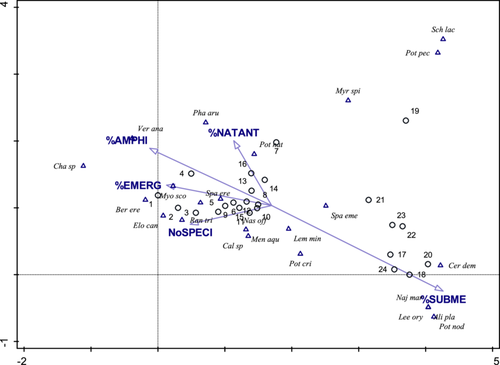
Table 1 shows the presence of the taxa recorded in 2003 and 2020 and their protective status in Slovenia. 13 taxa were present in 2003 only (not in 2020), while one taxon (Leersia orizoides) was present in 2020, but not in 2003. About 60% of the taxa (21 out of 35) were present in both years when the survey was performed (Table 1). Thirteen taxa, namely Acorus calamus, Iris pseudacorus, Najas minor, Nitella tenuissima, Phragmites australis, Potamogeton filiformis, P. perfoliatus, Ranunculus circinatus, R. fluitans, Spirodela polyrhiza, Typha angustifolia, and T. latifolia were found in 2003 only, but not in 2020 (Table 1), which might indicate a decrease in plant species richness. However, a direct comparison between the presence of macrophytes in both years is not possible because 112 sections were surveyed in 2003, and only 24 in 2020. Submerged macrophytes prevailed in both studied years, while the natant species reached a smaller proportion (Table 1). The proportion of submerged species increased downstream, which was found also by Riis et al. (2001). The Krka River is shallow and transparent to the bottom. The water level does not fluctuate significantly, which enables and facilitates the thriving of the submerged plants. On the other hand, natant species are more dominant in stagnant waters (Kumar et al., 2022), where there are no strong currents, which often flush them downstream in the rivers.
| Species/Year | 2003 | 2020 | Growth form | Red list | N/IA |
|---|---|---|---|---|---|
| Acorus calamus | yes | E | N | ||
| Alisma plantago-aquatica | yes | yes | E | N | |
| Berula erecta | yes | yes | E | N | |
| Callitriche sp. | yes | yes | S | N | |
| Ceratophyllum demersum | yes | yes | S | V | N |
| Chara sp. | yes | yes | S | N | |
| Elodea canadensis | yes | yes | S | IA | |
| Iris pseudacorus | yes | E | N | ||
| Lemna minor | yes | yes | N | N | |
| Leersia oryzoides | yes | E | N | ||
| Mentha aquatica | yes | yes | E | N | |
| Myosotis scorpioides | yes | yes | A | N | |
| Myriophyllum spicatum | yes | yes | S | V | N |
| Najas marina | yes | yes | S | V | N |
| Najas minor | yes | S | V | N | |
| Nasturtium officinale | yes | yes | E | N | |
| Nitella tenuisima | yes | S | N | ||
| Phalaris arundinacea | yes | yes | E | N | |
| Phragmites australis | yes | E | N | ||
| Potamogeton crispus | yes | yes | S | N | |
| Potamogeton filiformis | yes | S | V | N | |
| Potamogeton pectinatus | yes | yes | S | N | |
| Potamogeton natans | yes | yes | N | N | |
| Potamogeton nodosus | yes | yes | S | V | N |
| Potamogeton perfoliatus | yes | S | V | N | |
| Ranunculus circinatus | yes | S | V | N | |
| Ranunculus fluitans | yes | N | V | N | |
| Ranunculus trichophyllus | yes | yes | A | V | N |
| Schoenplectus lacustris | yes | yes | A | N | |
| Sparganium emersum | yes | yes | A | N | |
| Sparganium erectum agg. | yes | yes | A | N | |
| Spirodela polyrhiza | yes | N | V | N | |
| Typha angustifolia | yes | E | N | ||
| Typha latifolia | yes | E | N | ||
| Veronica anagallis-aquatica | yes | yes | E | N |
- Abbreviations: Growth forms (A, amphibian character; E, emerged; N, natant; S, submerged), Conservation status (V, vulnerable).
Five species found in both studied years were on the Red list of vulnerable plants (Uradni list. Republika Slovenija, 2002). This means that their habitat must be preserved to reduce the possibility of their extinction. These species are C. demersum, M. spicatum, P. nodosus, and R. trichopyllus. Among them, Najas marina is the rarest in Slovenian water bodies. The first reports for N. marina in Slovenia were in the 90s of the previous century when it was found in two artificial waterbodies. However, it has recently spread to more stagnant water bodies in Slovenia, but in limited areas. Distribution of the second species from the genus Najas in Slovenia, N. minor has been declining recently. For example, the species was present in one-third of the upper littoral zone of the Slivniško Lake in 2009 (Golob et al., 2015), but today, the species is no longer present in that lake.
About 75% of all European freshwaters are altered due to the management of the river and/or its catchment area (IPBES, 2019). Many freshwaters in Slovenia belong to the most endangered habitats (ARSO, 2021). It was recently reported that inland wetlands are highly vulnerable ecosystems on Earth and have one of the highest rates of decline in surface and biodiversity (Zelnik & Germ, 2023). The Krka River is threatened as far as its suitable habitats for aquatic organisms are concerned. Their extent may be reduced by increasing human influence, such as dams, channelization, and eutrophication. Excess input of nutrients from anthropogenic sources leads to massive plant growth and the decline of less competitive species (O'Hare et al., 2018).
3.2 Physical and chemical parameters
The temperature of the water, oxygen concentration, and saturation were the lowest at the spring of the river, while the conductivity was the highest there (Figures 7 and 8). These values are expected since the source area of the Krka is of a karst character. In the underground, the oxygen content and saturation are lower since there is no light and no primary producers to enrich the water with oxygen. In addition, due to the absence of primary producers underground, which could have consumed the nutrients from the water, and due to the higher content of carbonates leaching from the limestone bedrock, the conductivity of the water was also higher (Abubakr, 2010). Aboveground sections are highly overgrown with macrophytes that take up nutrients from the water and lower the conductivity. pH was around 7 in all sections. The concentration of nitrates dropped from 8.5 to 4.1 mg/L along the river course. The nitrate content decreased downstream due to the large biomass of macrophytes, which take the nitrates from the water (Kalengo et al., 2021). Densely vegetated water bodies may lower nitrates from spring waters, representing an important buffer system that reduces eutrophication downstream. It was also evidenced that ditches colonized by macrophytes provide a significantly higher nitrate removal rate than unvegetated ones (Soana et al., 2017).
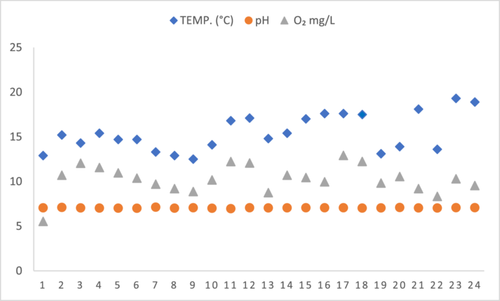
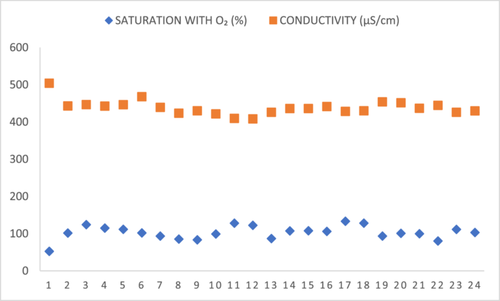
3.3 Assessment of environmental parameters
The results of the RCE inventory revealed that the surveyed sections belong to at least good class, except section 22 (Figure 9) (Petersen, 1992). According to the author, minor alteration in the river channel or riparian zone is needed. If we exclude the first two locations, the situation downstream deteriorates. The latter is a consequence of greater human activity in the river catchment, such as agriculture and industry, especially in the town of Novo mesto.
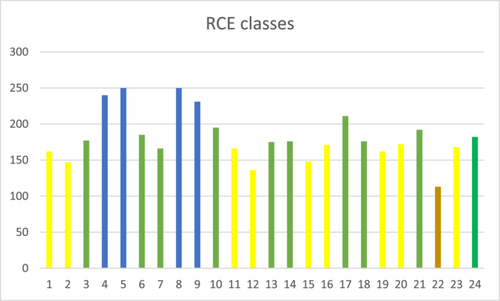
The number of the macrophyte taxa, the temperature, concentration of oxygen, and saturation were very low in the 22nd section. At the same time, this section was classified as fair according to the RCE inventory scores. The low score in the mentioned section is possibly the consequence of the surrounding great proportion of arable land, adjacent to the river, which covers a larger proportion of the catchment area there than in the case of other sections along the river. It is also possible that an underground spring flows into the river at this place. It can also be due to an influx of organic matter due to farms and settlements.
4 CONCLUSIONS
The diversity of macrophytes taxa in the river Krka was high, so the river is actually green in certain sections (Figure 10). It was expected since the river has slow flow with suitable substrate for anchoring the macrophytes and with the appropriate levels of nutrients. Riparian vegetation with shading also does not prevent the growth of macrophytes. The conductivity was decreasing downstream due to the uptake of inorganic nutrients by macrophytes. According to the RCE inventory, the river ecosystem shows a good state. We suggest regular monitoring of the state of macrophytes and environmental factors in the Krka River so that we can take appropriate action in case of possible deterioration.
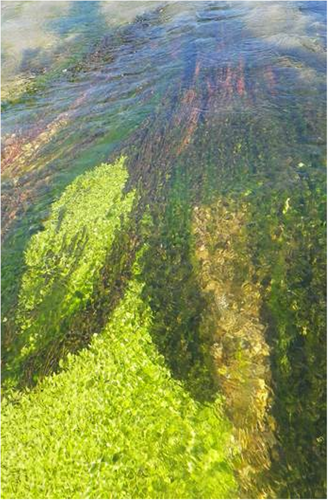
ACKNOWLEDGMENTS
The authors would like to thank Luka Šinkovec for his help in the field work. This research was funded by the Slovenian Research Agency, within the core research funding Nr. P1-0212, “Biology of Plants.”
ETHICS STATEMENT
None declared.
Open Research
DATA AVAILABILITY STATEMENT
The data that support the findings of this study are available from the corresponding author upon reasonable request.



